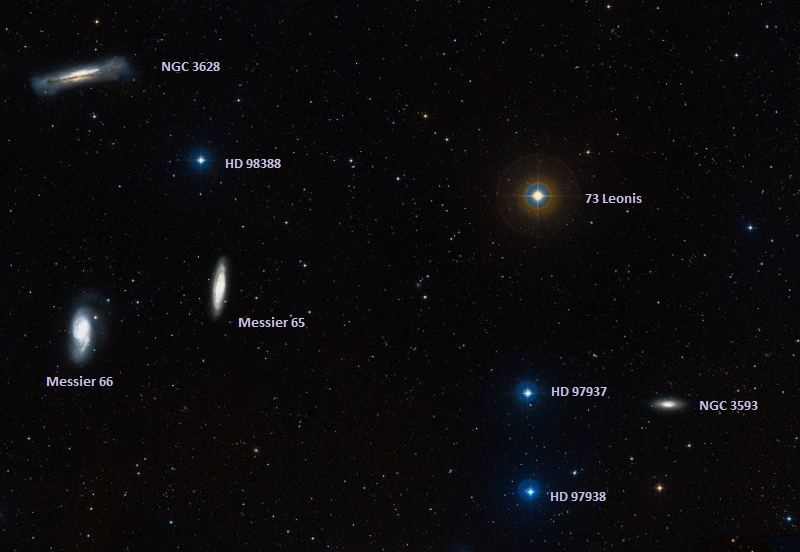Welcome back to Messier Monday! Today, we continue in our tribute to our dear friend, Tammy Plotner, by looking at the intermediate spiral galaxy known as Messier 66.
In the 18th century, while searching the night sky for comets, French astronomer Charles Messier kept noting the presence of fixed, diffuse objects he initially mistook for comets. In time, he would come to compile a list of approximately 100 of these objects, hoping to prevent other astronomers from making the same mistake. This list – known as the Messier Catalog – would go on to become one of the most influential catalogs of Deep Sky Objects.
One of these objects is the intermediate elliptical galaxy known as Messier 66 (NGC 3627). Located about 36 million light-years from Earth in the direction of the
Leo constellation
, this galaxy measures 95,000 light-years in diameter. It is also the brightest and largest member of the
Leo Triplet
of galaxies and is well-known for its bright star clusters, dust lanes, and associated supernovae.
Description:
Enjoying life some 35 million light years from the Milky Way, the group known as the "Leo Trio" is home to bright galaxy Messier 66 - the easternmost of the two M objects. In the telescope or binoculars, you'll find this barred spiral galaxy far more visible and much easier to see details within its knotted arms and bulging core.
[caption id="attachment_138527" align="aligncenter" width="580"]
Hubble image of the intermediate spiral galaxy Messier 66. Credits: NASA, ESA and the Hubble Heritage (STScI/AURA)-ESA/Hubble Collaboration/Davide De Martin/Robert Gendler[/caption]
Because of interaction with its neighboring galaxies, M66 shows signs of a extremely high central mass concentration as well as a resolved noncorotating clump of H I material apparently removed from one of the spiral arms. Even one of its spiral arms got it noted in Halton Arp's collection of Peculiar Galaxies! So exactly what did it collide with?As Xiaolei Zhang (et al) indicated in a
1993 study
:
Ah, yes! Star forming regions... And what better way to look deeper than through the eyes of the Spitzer Space Telescope? As R. Kennicutt (University of Arizona) and the SINGS Team
observed
:
[caption id="attachment_138530" align="aligncenter" width="580"]
Colour composite image of the spiral galaxy M66 (or NGC 3627) obtained with the FORS1 and FORS2 multi-mode instruments (at VLT MELIPAL and YEPUN, respectively). Credit: ESO
[/caption]
Messier 66 has also been deeply studied for evidence of forming super star clusters, too. As David Meier indicated:
But there's still more. Try magnetic properties in M66's spiral patterns. As M. Soida (et al) indicated in their
2001 study
:
History of Observation:
Both M65 and M66 were discovered on the same night - March 1, 1780 - by Charles Messier, who described M66 as, "Nebula discovered in Leo; its light is very faint and it is very close to the preceding: They both appear in the same field in the refractor. The comet of 1773 and 1774 has passed between these two nebulae on November 1 to 2, 1773. M. Messier didn't see them at that time, no doubt, because of the light of the comet."
Both galaxies would be observed and cataloged by the Herschel family and further expounded upon by Admiral Smyth:
[caption id="attachment_138529" align="aligncenter" width="472"]
Messier 66 location. Credit: IAU and Sky & Telescope magazine (Roger Sinnott & Rick Fienberg)
[/caption]
Locating Messier 66:
Even though you might think by its apparent visual magnitude that M66 wouldn't be visible in small binoculars, you'd be wrong. Surprisingly enough, thanks to its large size and high surface brightness, this particular galaxy is very easy to spot directly between Iota and Theta Leonis. In even 5X30 binoculars under good conditions you'll easy see both it and M65 as two distinct gray ovals.
A small telescope will begin to bring out structure in both of these bright and wonderful galaxies, but to get a hint at the "Trio" you'll need at least 6" in aperture and a good dark night. If you don't spot them right away in binoculars, don't be disappointed - this means you probably don't have good sky conditions and try again on a more transparent night. The pair is well suited to modestly moonlit nights with larger telescopes.
May you equally be attracted to this galactic pair!
And here are the quick facts on M66 to help you get started:
- Object Name
-
Messier 66
- Alternative Designations
-
M66, NGC 3627, (a member of the) Leo Trio, Leo Triplet
- Object Type
-
Type Sb Spiral Galaxy
- Constellation
-
Leo
- Right Ascension
-
11 : 20.2 (h:m)
- Declination
-
+12 : 59 (deg:m)
- Distance
-
35000 (kly)
- Visual Brightness
-
8.9 (mag)
- Apparent Dimension
-
8x2.5 (arc min)
We have written many interesting articles about Messier Objects here at Universe Today. Here's Tammy Plotner's
Introduction to the Messier Objects
,
M1 – The Crab Nebula
, and David Dickison's articles on the
2013
and
2014
Messier Marathons.
Be to sure to check out our complete
Messier Catalog
. And for more information, check out the
SEDS Messier Database
.
Sources:
- NASA - Messier 66
- *ESA - Spiral Galaxy Messier 66*
- *Messier Objects - Messier 66*
- *Wikipedia - Messier 66*
 Universe Today
Universe Today
